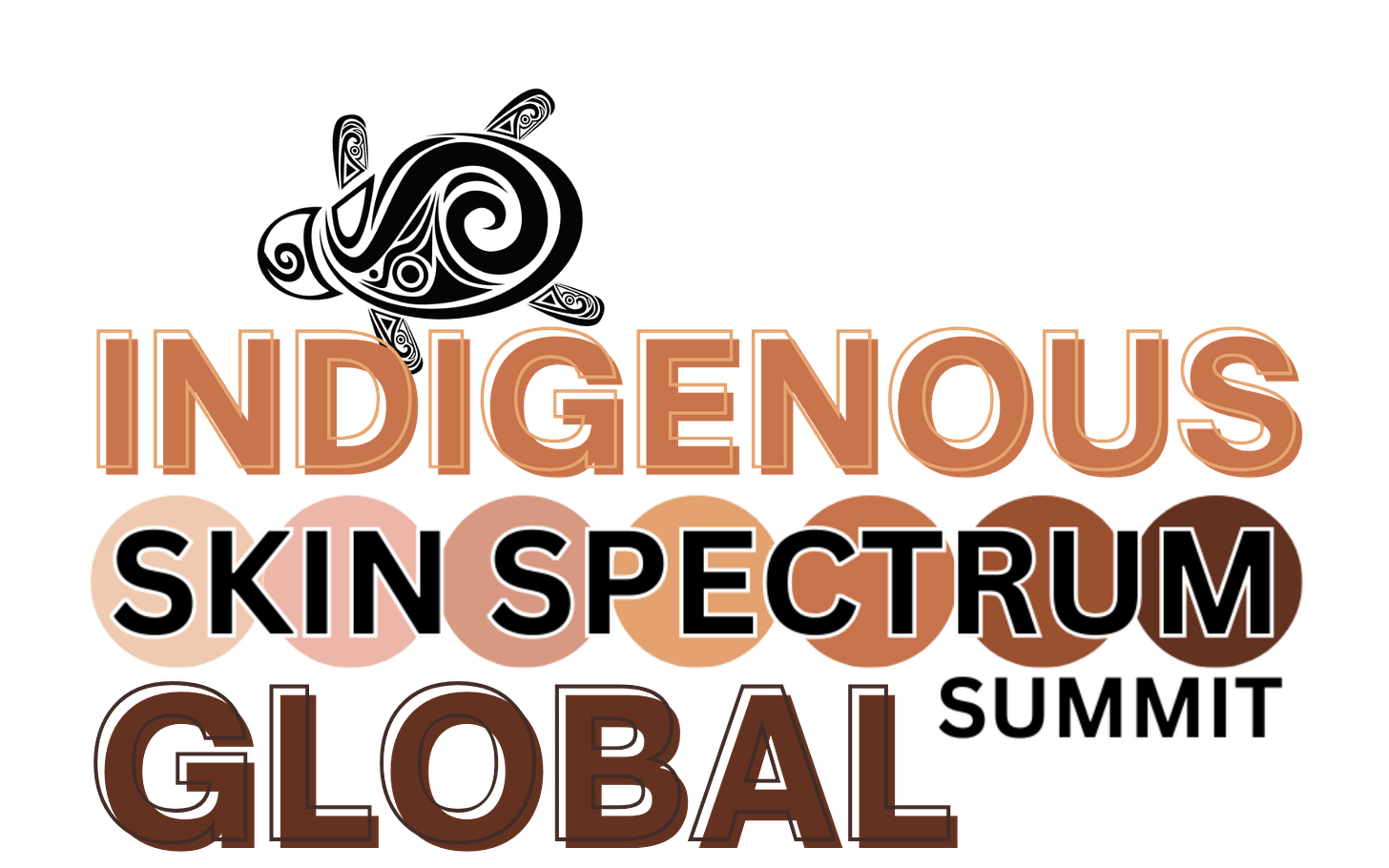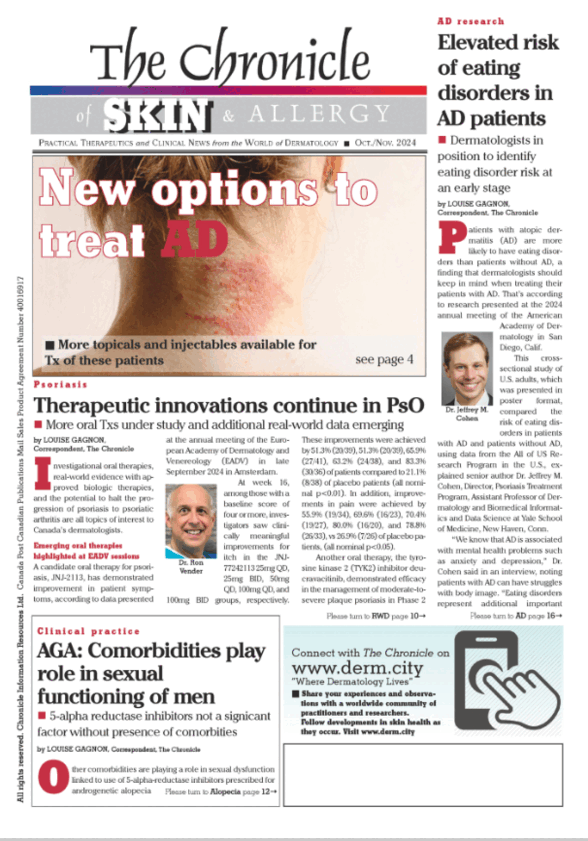Educating Indigenous Atopic Dermatitis patients
Engaging with traditional ways of knowing improves communication, reduces patient distress (Issue #234, 1,300 words, 7 minutes)
Strong two-way communication is needed between physicians and Indigenous patients with atopic dermatitis to address language and infrastructure barriers that can impair care and patient confidence, Dr. Carolyn Jack said during a presentation at the fourth annual Indigenous Skin Spectrum Summit on Oct. 4, 2024, in Toronto. Integrating traditional ways of knowing and living into educational materials is vital.
Dr. Jack is an assistant professor of dermatology at McGill University in Montreal and a junior scientist in the Infectious Diseases and Immunity in Global Health Program at the Research Institute of McGill University Health Centre. In 2018, Dr. Jack founded the McGill University Hospital Network Centre of Excellence for Atopic Dermatitis, Canada's first tertiary care centre dedicated to adult atopic dermatitis (AD).
Dr. Jack said physicians must be sure that a patient has AD before beginning the complex process of explaining and treating the condition. AD care can be especially complex in remote and rural areas, where access to care and pharmacies may be lacking. She said physicians must consider improving the effectiveness of care for patients in those areas and reducing secondary infection and household burden. Physicians also must remember that health is intrinsically linked to traditional lands and resources in remote Indigenous communities, and knowledge is passed on collectively.
Dr. Jack said physicians should consider potential barriers to communication and the distress that may be caused if patients do not understand care instructions before proposing treatment options.
Dr. Jack said they are attempting to integrate more information about Indigenous ways of knowing, doing, and being into their approach and educational materials at the clinic she runs.
Bottom Line: AD treatment may be especially complex in remote and rural areas, where access to care and pharmacies may be lacking. Indigenous patients may have a traditional way of understanding health and care, so physicians must find ways to communicate the nature of AD and treatment programs to these patients in ways they can understand. Unclear communication about disease and treatments can cause significant patient distress.
From the literature on atopic dermatitis in skin of colour
Racial and ethnic disparities in pediatric atopic dermatitis
For this study, researchers compared the healthcare utilization and management of 4,008 children with atopic dermatitis (AD) using the number of AD-related healthcare visits, prescriptions, testing, and subspecialty referrals. As part of their analysis, the investigators compared racial and ethnic groups (Black, Hispanic, Asian, and Other) with the reference group of non-Hispanic White, while adjusting for common confounders.
The mean number of urgent care visits for the Hispanic group was 1.61 times that of the non-Hispanic White group, and the mean number of emergency department visits was 3.71 (p<0.001) times the reference group. Black or African American patients had a mean number of emergency department visits that was 1.52 times that of non-Hispanic White patients (p=0.021). The mean count of primary care visits was lower among Hispanic patients and higher among Asian patients (p=0.012). Visits to subspecialty clinics and hospitalizations did not differ significantly. There were no consistent patterns in differences in AD-related prescriptions, testing, or subspecialty referrals.
Joint genotype and ancestry analysis identify novel loci associated with atopic dermatitis in African American population
This paper presents a joint analysis of ancestry and genotype effects followed by validation using differential gene expression analysis on atopic dermatitis (AD) using 726 AD-affected individuals and 999 non-AD control individuals from the U.S. African American (AA) population. The individuals were genotyped using Multi-Ethnic Global Array (MEGA) followed by imputation using the Consortium on Asthma among African Ancestry Populations in the Americas (CAAPA) reference panel.
Investigators identified two novel AD-susceptibility loci, rs2195989 in gene ANGPT1 (8q23.1) and rs62538818 in the intergenic region between genes LURAP1L and MPDZ (9p23). The researchers found potential genomic inflation, and after implementing genomic control they identified five ancestry-of-origin loci with European ancestry effects. The multi-omics functional prioritization of variants in AM signals prioritized the loci SLAIN2, RNF39, and FOXA2.
Performing a genome-wide association study, the authors identified variants significantly associated with AD in the AA population, including SGK1 (rs113357522, odds ratio [OR] =2.81), EFR3A (rs16904552, OR=1.725), and MMP14 (rs911912, OR=1.791). Researchers note GWAS variants were common in the AA but rare in the European population, suggesting an African-ancestry-specific risk of AD. They further validated four genes (ANGPT1, LURAP1L, EFR3A, and SGK1) using qPCR from AD and healthy skin.
In their conclusions, the authors say the findings highlight the importance of genetic studies on admixed populations, as well as local ancestry and genotype-ancestry joint effects, to identify risk loci for AD.
Dupilumab impact on psychiatric and sleep disorder risk reduction in atopic dermatitis: A population-based cohort study
Researchers compared the risk of psychiatric and sleep disorders in patients with atopic dermatitis (AD) treated with dupilumab vs those on conventional medications, including systemic corticosteroids, methotrexate, cyclosporin, and azathioprine.
Investigators examined data on adult patients with AD newly prescribed dupilumab (DUPI-cohort) or conventional medications without previous dupilumab exposure (CONV-cohort), both with 6,114 patients. The racial distribution in both cohorts was approximately 49% White, 15% Black or African American, and 12% Asian.
Researchers matched propensity scores for age, sex, race, comorbidities, and laboratory measures. The researchers compared the risks of various psychiatric disorders, such as anxiety, depressive disorders, adjustment disorders, and attention deficit hyperactivity disorder, including sleep disorders, and determined hazard ratios.
During a three-year follow-up, the DUPI-cohort had reduced risks of anxiety (hazard ratio 0.76, 95% CI 0.64-0.89), depressive disorders (0.70, 0.58-0.86), adjustment disorders (0.535, 0.37-0.78), and sleep disorders (0.78, 0.65-0.94), whereas the risk of attention deficit hyperactivity disorder was not significantly affected (0.92, 0.61-1.38). These findings were consistent across age groups, sexes, races, and atopic comorbidities, with a more pronounced effect in Black or African American patients.
VIDEO: IDEF Educational Series Mild to Moderate Atopic Dermatitis in Skin of Color Patients
Dr. Jennifer Soung, a dermatologist from Santa Ana, Calif., reviews the evolving understanding of atopic dermatitis (AD) and clinical considerations when treating skin of colour patients with AD in this instalment from the International Dermatology Education Foundation (IDEF).
At the intersection of skin and society
Warrant Officer Robert-Falcon Ouellette, a member of the Cree nation and a former member of Parliament, has been named the Canadian Armed Forces' first Indigenous Knowledge Keeper, reports CBC News.
From 2015 to 2019, Ouellette represented the riding of Winnipeg Centre as a Liberal MP.
Ouellette was promoted to captain in a ceremony hosted by the military in Winnipeg on Thursday, Jan. 30.
"It's about the inclusion of Indigenous Peoples fully within the institutions of our nation," Ouellette said in an interview ahead of the ceremony.
"We've moved in such a way with reconciliation that we have this opportunity to really demonstrate what the Canadian Forces can be."
Ouellette will become the first member of the Canadian military designated to proto be vide spiritual teachings from an Indigenous point of view.
Inperspectivelains have existed in the past, including Lt.-Col. Catherine Askew, but this is the first time someone has been designated to provide spiritual teachings from an Indigenous point of view instead of a Christian one, according to the article. Before this, chaplains would have to rely on a network of Indigenous representatives for spiritual and emotional support.
In the interview, Ouellette described a time when he faced harassment for being Cree.
"There were times when I had terrible discussions with commanding officers and others within my unit. I have long hair and sometimes that would upset people who are older military members," he recalled.
"Today, it's much different. People are much more accepting."
Ouellette said his role is to support Indigenous people and educate non-Indigenous members.
This week
February is Black History Month
Feb. 11 is International Day of Women and Girls in Science
Feb. 15 is International Childhood Cancer Day
Something to think about in the week ahead . . .
—Friedrich August von Hayek, Austrian economist (1899–1992)
Next week
Skin Spectrum Summit is taking Monday, Feb. 17, off for Family Day. We will return on Monday, Feb. 24.
Register now for the first Global Indigenous Skin Spectrum Summit in Montreal
Skin Spectrum Weekly readers are invited to register for the first Indigenous Skin Spectrum Global Summit, which will be held in Montreal on April 5, 2025.
The summit will allow attendees to learn more about the unique dermatologic challenges facing Indigenous populations worldwide. Experts worldwide will provide insights on how physicians can support equitable health for these populations.
Summit chair Dr. Rachel Asiniwasis (Regina) leads a world-renowned faculty that includes Dr. Rachel Pugh (Australia), Dr. Carsten Sauer Mikkelson (Denmark), Dr. Monique Mackenzie (New Zealand), Dr. Anna Chacon (Florida), Dr. Dana Slape (Australia), Dr. Carolyn Jack (Montreal), and other thought leaders.
More details on the Global Summit will appear in future editions of Skin Spectrum Weekly.
If you enjoy Skin Spectrum Weekly, why not check out the Chronicle’s other publications, podcasts, and portal?
Established in 1995, The Chronicle of Skin & Allergy is a scientific newspaper providing news and information on practical therapeutics and clinical progress in dermatologic medicine. The latest issue features:
Drs. Ilya Shoimer (Calgary), Michael Stevens (Bedford, NS.), and Mark Lupin (Victoria, BC) discuss the current strategies for managing actinic keratoses, including identifying the risk of progression to squamous cell carcinoma.
Dr. Irina Turchin (Fredericton, NB) describes findings from recent research on the safety and efficacy of topical roflumilast 0.3% in treating psoriasis.
Drs. Yuka Asai (Kingston, Ont.), Benjamin Barankin (Toronto), Fiona Lovegrove (London, Ont.), and Sam Hanna (Toronto) review some of the significant dermatologic treatment approvals of 2024.
Plus regular features, including the popular column “Vender on Psoriasis” by dermatologist Dr. Ron Vender.
You can read a recent digital edition of The Chronicle of Skin & Allergy here. To apply for a complimentary subscription or to request a sample copy, please email health@chronicle.org with your contact information.
The Women in Dermatology e-newsletter updates readers with new findings concerning dermatologic issues affecting women and the female dermatologists who care for them. Read the current issue here.
Season three of the Vender on Psoriasis podcast with Dr. Ron Vender has begun. Listen to the new season here. In episode five, Dr. Vender discusses whether vitamin D influences psoriasis severity, sex differences in psoriatic inflammation itch, and the risk of psychiatric disorders associated with acitretin.
And if you’re looking for a web destination for all things derm, visit derm.city, “Where Dermatology Lives.” Please like, rate, review, and share it with your colleagues.









